Built on a probability-based sample, Epistorm-Mix delivers population-level contact matrices and mixing indicators that reflect real-world heterogeneity across age, sex, race/ethnicity, income, and settings. These data enable epidemic models to better capture differential infection risks and to test targeted interventions in silico—offering actionable insight for seasonal preparedness and pandemic response.
Use Epistorm-Mix to integrate realistic contact patterns into respiratory-disease models.
Repository with code, data, and tutorials:

Epistorm-Mix is the first dataset containing contact patterns for all ages of the US population collected during the post-pandemic era from a statistically representative sample.
The dataset contains sociodemographic characteristics of respondents and of each of their contacts such as age, sex, race/ethnicity. Moreover, the data includes a set of additional key information on the contact such as the relationship between the contactor and contacted individual, type/frequency of contact, and social setting where the contact took place.

Contact matrices has long been used to summarize complex human interactions in the context of infectious disease spread, but the data for the US has been limited and even in other countries matrices are mostly provided in a single dimension – age. The collected contact patterns data was thus used to estimate contact matrices that capture interactions between different population groups both overall and stratified for key transmission setting (home, work, school, and community). Based on the information collected about the participants and their contacts, the matrices provided here are stratified not only by age, but also by race/ethnicity and sex to allow for the incorporation of heterogeneities between population groups into infectious disease modeling and forecasting tools.
We provide a series of tutorials to help you get started with Epistorm-Mix. Each tutorial includes annotated code examples to support practical, hands-on learning.




Epistorm-Mix: Mapping Social Contact Patterns for Respiratory Pathogen Spread in the Post-Pandemic United States
Maria Litvinova, et al. medRXiv 2025.
Developing epidemic models that accurately capture transmission processes within a population requires using current data that is representative of the target population. Epistorm-Mix provides contact patterns data for a sample of the US population that is nationally representative by age, sex, race/ethnicity, household income, census region, and language. The data was collected in 2024, providing a snapshot of post-COVID-19 contact patterns in the US. Epistorm-Mix contact pattern data enables researchers and public health professionals to develop mathematical/computational models of epidemic spread and can be used to better prepare for emerging threats and inform the design and execution of public health interventions aimed at mitigating the spread of respiratory infectious diseases.
This project is supported by cooperative agreement CDC-RFA-FT-23-0069 from the CDC’s Center for Forecasting and Outbreak Analytics. Its contents are solely the responsibility of the authors and do not necessarily represent the official views of the Centers for Disease Control and Prevention.
Indiana University
Maria Litvinova
Marco Ajelli
Shelly Sinclair
Allisandra Kummer
Paulo Ventura
Northeastern University
Alessandro Vespignani
Fred Hutchinson Cancer Center
M. Elizabeth Halloran
Boston University
Kayoko Shioda